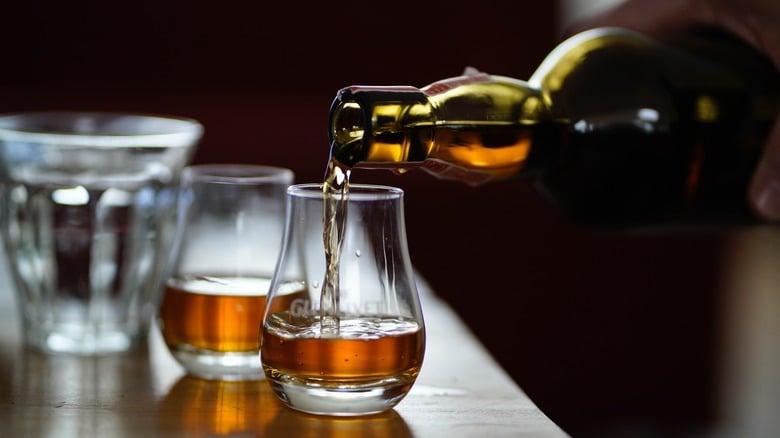- 17 Posts
- 44 Comments

 2·1 year ago
2·1 year agoGreat review! Personally I found Scorch to be a disaster - a bland, uninteresting dram with less depth and complexity than Uigeadail at two or three times the price. Honestly it put me off special edition Ardbeg for the time being. It doesn’t sound like Harpy’s Tale would be the one to change my mind either. Perhaps it’s just as well I haven’t seen it available where I live.

 2·1 year ago
2·1 year agoDistiller: Art of the Spirits
Product: Easy Elegance
Bottle: -
Category: Rye
Aged: 6 years American oak
Nose: Holiday fruitcake with plums, cherries, and figs baked in honey and spices. Surprising from a straight rye.
Body: Cinnamon, white peppercorn, pears, and figs over a base of spearmint fluoride mouthwash.
Finish: Pine needles and more spearmint give a crisp clean finish. I still think of the dentist’s chair, but it’s not an unpleasant combination.
Activation: Feels a bit buttery and creamier. Nothing too dramatic.
Notes: The fifth and final entry of this series, Easy Elegance is also the only spirit that comes to us fresh from the oak with no particular finishing run. I’d forgive you for thinking that there was a port or sherry involved here however as there is a fruit character not commonly seen in rye whiskey. I’m also a sucker for mint flavors in my whiskey, so the strong spearmint tones are right down my alley. Taken together, this might be my favorite of the lot.

 2·1 year ago
2·1 year agoDistiller: Art of the Spirits
Product: The Originals
Bottle: 4 Square Rum Finish
Category: Whiskey
Aged: 6 years American oak finished in rum
Nose: Anise, creamy butterscotch, allspice.
Body: Licorice, but the fake sugary kind from a Twizzler’s candy. Cinnamon, brown sugar, cloves, and other spices.
Finish: Apple cider, nutmeg, and with a bit of a harsh tobacco at the very end.
Activation: A bit sweeter, some raw cane sugar with your spice blend. Not overly noticeable.
Notes: Our next Art of the Spirits offering is the Originals, named in honor of the 10th Special Forces group from the OSS in WW2 and featuring an oil painting that wouldn’t be out of place on a Call of Duty game. It’s at the same time familiar (rum barrels often leave behind blends of cinnamon and spice) and quite unique - the licorice flavors are something I’m not used to. If you told me the rum was mixed with a hit of absinthe I would believe you. To be honest I don’t love it, certainly not at this price point.

 2·1 year ago
2·1 year agoDistiller: Art of the Spirits
Product: Final Run
Bottle: Tawny Port Finish
Category: Whiskey
Aged: 6 years American oak finished in tawny port
Nose: Very mild. Roasted walnuts and fresh pine needles.
Body: Drier and more oak-forward than the previous expressions. Lots of nutty flavors: walnuts, pecans, pistachios. The sweetness this time comes from sort of an eggy creme brulee with caramelized sugar topping.
Finish: Finally some traditional port characteristics - cherries, cranberries, and spiced apple cider.
Activation: Ah now here it gets interesting. A splash of water cools it down, tames some of the resins and brings out a ton of autumnal flavors: cranberries, pumpkin spice, nutmeg. The first of the Final Runs that I would recommend this on.
Notes: Being a whiskey nerd and not a wine nerd, I was dubious that there would be much of a difference between a ruby port and a tawny port finish. At the end of the day it’s all the same grape right? Apparently the difference comes from the aging process, with tawny ports aging in smaller casks that extract more oak flavor and turn the wine brown (hence the name). When applied to a spirit the difference is dramatic. This is a much more savory whiskey, with all kinds of nuts and spices that can’t help but conjure images of Thanksgiving dinner, mulled wine, and spiced desserts on a cool night. If I had to choose I would probably give the edge to the ruby, but as with anything it’s a matter of preference and circumstance.

 2·1 year ago
2·1 year agoDistiller: Art of the Spirits
Product: Final Run
Bottle: Madeira Cask Finish
Category: Whiskey
Aged: 6 years American oak finished in madeira sherry
Nose: That distinctive tangerine body, this time laden with a rich floral honey mixed with dulce de leche.
Body: The rich caramel continues over a sweet cookie base. I’m reminded quite strongly of traditional alfajores. There’s something else as well, a barnyard hay or alfalfa quality with just enough of a sour grape note to remind you of the wine finishing.
Finish: Faint honey drizzled pastries fade altogether too quickly.
Activation: Becomes a bit more traditional, bringing out the green grape and apple flavors I would have initially expected. It’s not bad, but I prefer the uniqueness of the original.
Notes: Near as I can tell, this is the exact same base spirit as the port finished Final Run, just finished in madeira sherry instead. Generally on such things I prefer the richer, deeper flavors from a port cask but don’t count this one out yet. The sweet dulce de leche is so evocative and so unique that I struggle to think of anything else while I taste this. From originality alone, this one wins a place of honor on my shelf. For those counting, that is 2 for 2 for the upstart little distillery from Colorado Springs.

 2·1 year ago
2·1 year agoDistiller: Art of the Spirits
Product: Final Run
Bottle: Ruby Port Finish
Category: Whiskey
Aged: 6 years American oak finished in ruby port
Nose: Vanilla and tangerines with a hint of fresh spearmint.
Body: A sweet corn base is layered with rich wine tannins. Ripe plums and virgin olive oil over a chewy leather foundation.
Finish: Fresh oak, a dry Mexican style vanilla and a faint mint leaf conclusion leave you wanting more.
Activation: Accentuates some of the fruit flavors: more plums, cherries, and even some dark grapes. Personally this makes things a bit too sweet for my taste and I prefer the neat expression.
Notes: And so the Art of the Spirits rundown begins with a bang, Bonnie and Clyde style. The ruby port variant of the Final Run is rich, decadent, and expressive. At a shade over 107 proof, this whiskey is bold and unapologetic but not coarse or harsh. Sweet fruits lend a dessert-like quality while adroitly avoiding the syrupy or medicinal connotations all too common in wine-finished whiskey. The price point is aggressive, but remember that this is a limited edition cask strength bottling and therefore was never in the running to be the next daily sipper. All in all, a strong opening salvo from Art of the Spirits and I’m excited to try the rest of the range.

 1·1 year ago
1·1 year agoWelcome, and thanks for a great review! The past few Octomores that I have tried have been big, heavy, peat-filled punches in the mouth - enjoyable in their own way, but a far cry from subtle. Interesting that the 13.2 does not follow this pattern; I’ll have to look around and see if I can find one.
As someone who has spent untold hours writing hundreds of these reviews (a few of which are posted here) that probably no one agrees with, I have to say you’re thinking about tasting notes in the wrong way however. The short answer is there’s never a “correct” tasting - it’s less about writing an accurate product description and more like a film critic reviewing a movie. You describe your unique experience with the whiskey, explore what it make you think of and how it made you feel, and other readers are free to agree with some, all, or none of your conclusions.
Now for the long answer:
Let’s start with remembering what whiskey actually is. We take a variety of grains, cook them to break them down into sugars, and then feed that sugar to trillions of tiny organisms that eat sugar and crap out ethanol and some other stuff. We take that, boil off some bits that we don’t want, and slosh the good part around in some burnt wood for a while. Then we add a bit of water back in and pour it in a bottle. Maybe I think the result tastes like cinnamon cookies, but you think it tastes like dirty gym socks. The reality is neither of those things are actually in this bottle! Therefore neither of us is right; both opinions are equally valid (and equally ridiculous). Mine is just more likely to be printed on the label, which is after all a marketing tool first and foremost.
So how did we come up with such wildly different tastes? Tons of reasons, up to and including genetics. Some people famously think that cilantro tastes like soap. Women are generally more sensitive to sulfides than men and therefore less likely to enjoy dry red wine. There’s uncountable other more subtle differences based on how diets evolved over millions of years.
Perhaps more important is that we each bring our own experiences. Smell and taste are both closely linked to memory - perhaps what makes you remember your grandmother’s pecan pie makes me remember that night in college where I vomited up half a bottle of Southern Comfort. We would use very different adjectives to describe the same flavor! Similarly, your brain will make connections based on what it has seen before. Perhaps the first ever peated Islay you had, all you could taste was the smoke, but now you’re writing a complex review of a famously heavy dram. What we are currently experiencing is also important - something is going to taste very different in a smoky pub, or after a big meal, or while your seasonal allergies are acting up.
So then, are all reviews just arbitrary bullshit? Well, that might depend on how you feel about art critics! I think they drive discussion, expand horizons, and help call out subtleties and complexities that each of us may have missed in our first pass. At the very least, they can be useful in the aggregate. You might disagree with any particular review, but if everyone else is mentioning vanilla and sugar cookies and citrus in their review, you can be reasonably certain that you won’t taste dark chocolate and coffee grounds. And if you do, that says something interesting about your particular palate that you may want to explore further. And there are a few ways that we can make our reviewing experience better and less arbitrary:
First, I find a routine is important - it sounds like you may already have this part down. To limit as many confounding variables as I can, I always review by following the same steps in the same environment, in as close to the same headspace as I can be. For me that means in my office, never after eating, never while drunk but also not trusting the first sip or two as my taste buds awaken. Some folks swear by the Glencairns but I don’t personally find the type of glassware to be all that significant - if you do, that’s something else to add to the list. There are tons of resources online about the “correct” way to taste whiskey, but all that really matters is you take your time and are thoughtful about each element in turn.
Secondly, it sounds like you may be struggling to isolate or verbalize what exactly it is that you’re tasting. When that happens to me, I find a flavor wheel to be a useful tool to help narrow things down. Again there are no wrong answers here but it can help you be more specific. And don’t be discouraged if you don’t come up with 20 unique flavors - some whiskey is just naturally less complex but that doesn’t mean it’s less tasty.
Finally, experiment with side-by-side comparisons wherever possible! One of the best ways to notice new things about a whiskey is to directly compare it another of a similar profile. For instance, the Dalmore 12, 14, and 15 should in theory be quite similar, and you could probably identify any of them as being “a Dalmore”. But if you try one right after another look out - there’s no mistaking one for the others; they have wildly different profiles. Other brands take the same base whiskey and then just age it in different ways - this is a great way to isolate what flavors are coming from the malts vs the finishers.
Apologies for the novel; hopefully something in here was useful to you. I hope you stick with the hobby and look forward to reading more of your notes in the future!
Possibly because I know nothing about tarot, some of these connections seem odd to me (Zorayas as the sun? Fia as judgement? Blaidd as the chariot??) That said, the artwork is beautiful. Nephali as Temperance is probably my favorite. Great work!

 4·1 year ago
4·1 year agoVote for 3.
Honorable mention for 11 but all of these are fantastic. Great job by the artists.

 3·1 year ago
3·1 year agoSorry, I don’t use wefwef. In the main browser, you can navigate to the community and the “block” button is right below the “subscribe” option.

 43·1 year ago
43·1 year agoNear as I can tell, there are certain communities that have a “rule” that every time you browse that community, you must post something before you leave. This leads to a lot of low effort shitposting that I guess some people find fun but I just blocked those communities so my /All feed wasn’t cluttered.

 23·1 year ago
23·1 year agoI don’t love this example because enjoyment of the object isn’t really a cost. If I buy a book or a videogame or a movie, the time it takes to enjoy the media is the value, not the cost.
If you’re talking about maintenance and upkeep on your car, that is a different type of cost that has to be weighed against the cost and time expenditure of a bus pass or whatever your alternative was.
In other words I feel like this is a catchy phrase that kind of falls apart once you start to dig at it.

 9·1 year ago
9·1 year agoI feel like there’s a lot more to this than “pay it twice”. If you’re talking purely in dollars, then you’ll want to consider maintenance and upkeep over the expected lifetime of the object and compare that to alternatives. Additionally, everything has an opportunity cost because no resource is limitless and you could have allocated it elsewhere. Finally, emotional and other intangible benefits are something that most people have a very difficult time quantifying.
If you want to say “consider more than just the purchase price” then I’m with you.

 31·1 year ago
31·1 year agoI’m not certain all that is necessary but I agree there should be no more than one active vote at a time and it should be pinned to the top. It’s quite easy to miss what’s going on if you don’t happen to log in every day.
 2·1 year ago
2·1 year agoI have an awful 1.5 hour commute to work. Ideally I’d like to be fully remote - but my company insists that isn’t going to happen. My second choice would be convenient, safe, and affordable public transit - but my city insists that isn’t going to happen. Autonomous cars wouldn’t be a perfect solution but it would be a heck of a lot better than the road-raging humans I have to deal with now.

 1·1 year ago
1·1 year agoTough call but I’d probably have to go with Dark Cove. Good luck finding one these days that doesn’t cost an arm and a leg though.
I’ve tried a number of different weapons for my (un-optimized, PVE only) arcane build but I keep coming back to Elonara’s poleblade as the most fun. The double-handed move set feels fantastic, it applies bleed well, the Ash of War can initiate and then make space by retriggering. And the charged R2 is so damn satisfying. Throw in Flame Grant Me Strength and maybe a dragon incantation or two and it’s a very versatile setup- at least for PVE.

 15·1 year ago
15·1 year agoI agree with the spirit of this 100% and will support any way I can. I only hope the implementation is free of trolls, bots, and other bad actors.

 2·1 year ago
2·1 year agoI don’t love this idea either but let’s tone the hostility down eh? Got a friendly community here, let’s keep it that way.











To start with, my buddy and I have a holiday tradition of sharing the Whisky Exchange’s holiday blend. I get the feeling we will find excuses for plenty of other bottles as well though - nothing beats a dram to warm you up on a cool fall night. Let us know how the advent calendar works out for you.